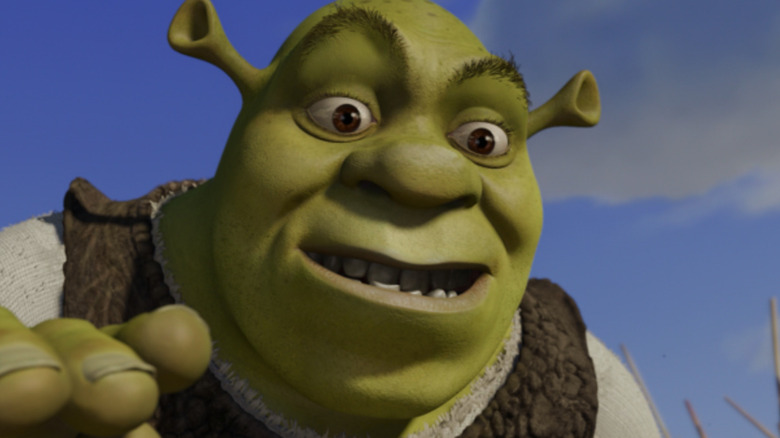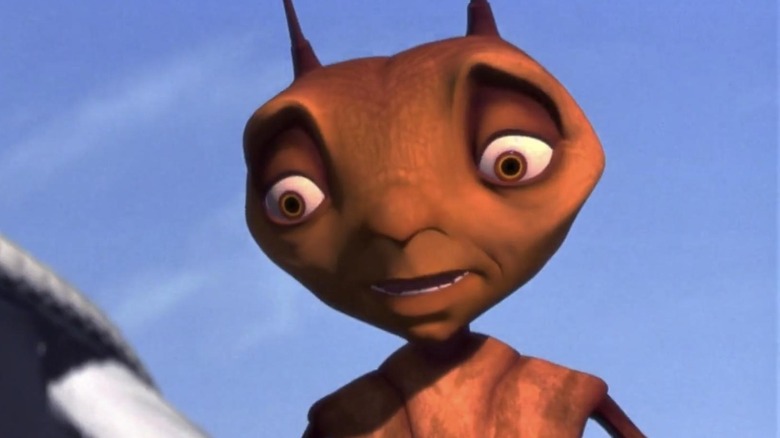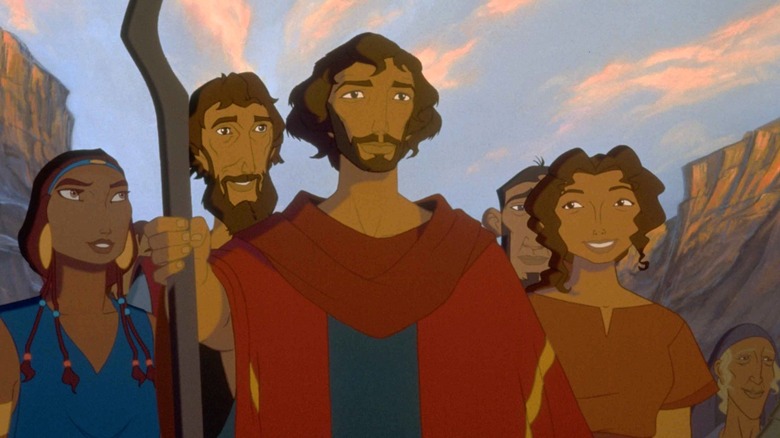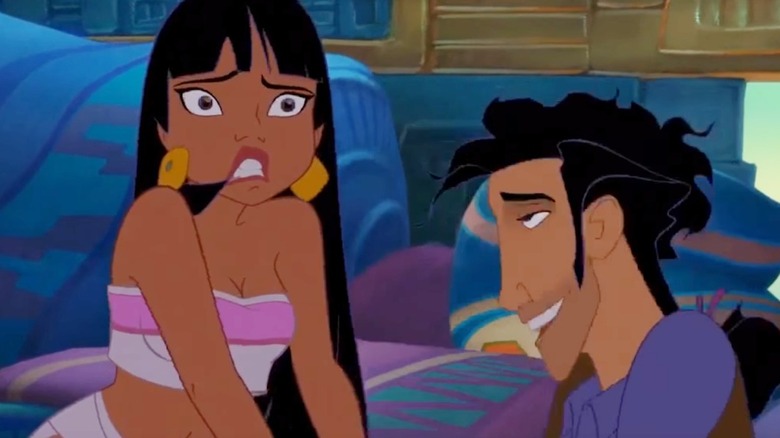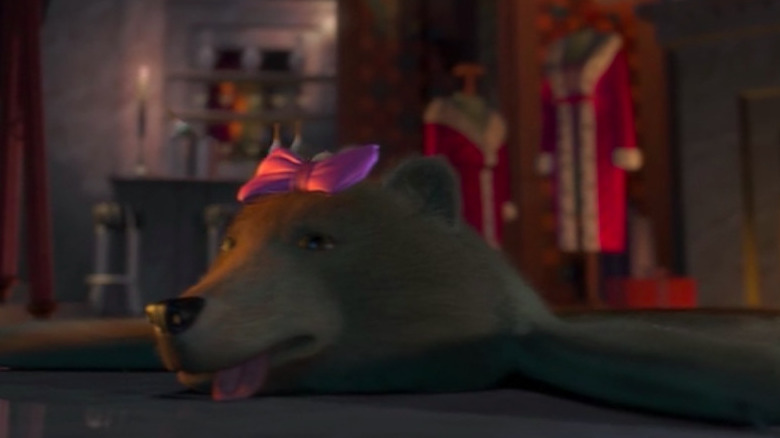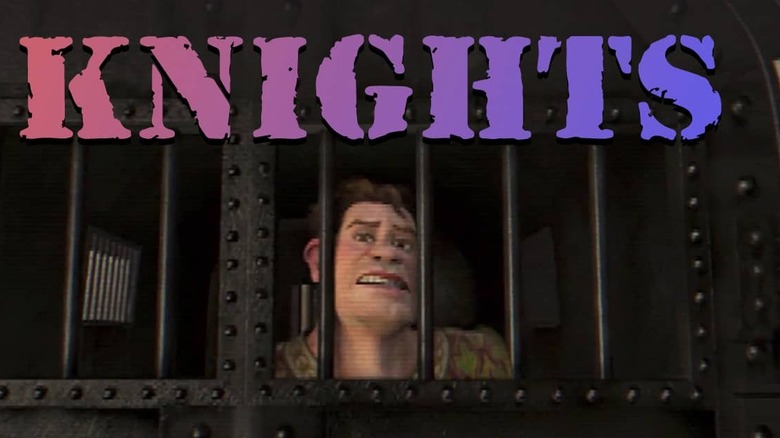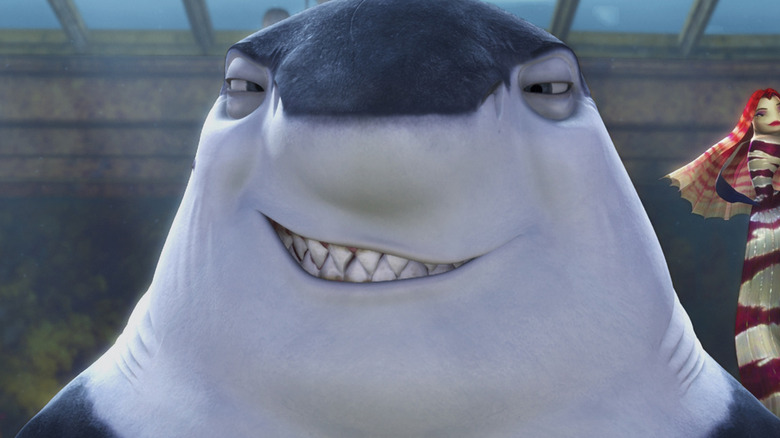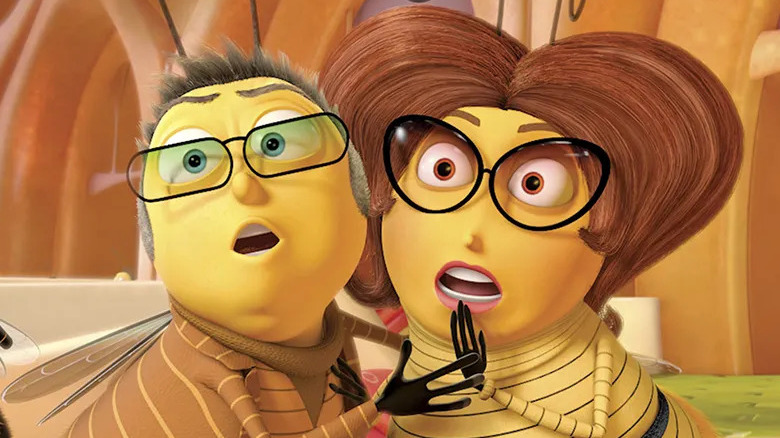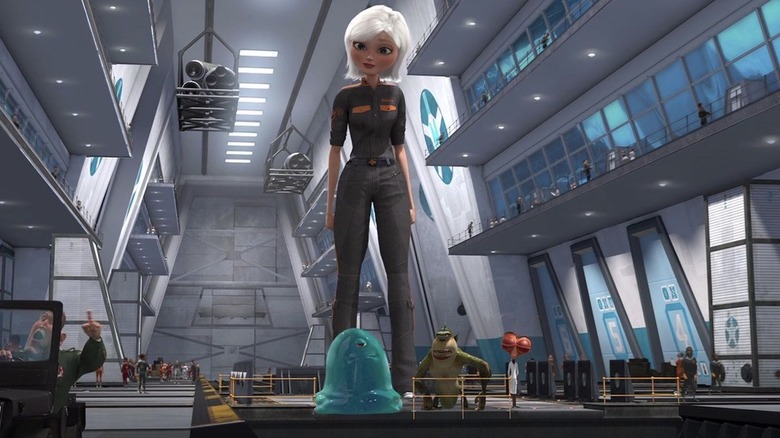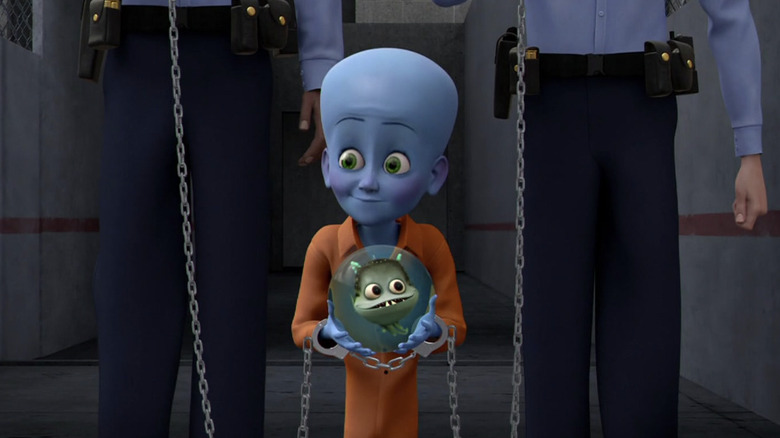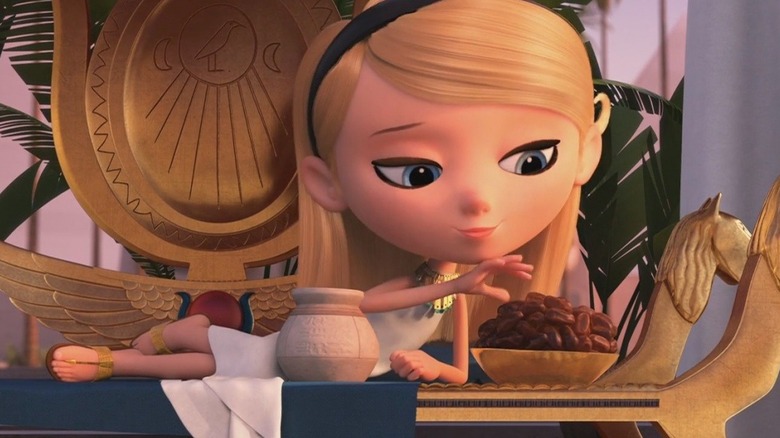Controversial Things Hidden In DreamWorks Animation Movies
DreamWorks SKG studios was founded in 1994 as the brainchild of director/producer Steven Spielberg, former Disney executive Jeffrey Katzenberg, and business magnate David Geffen (via Entertainment Weekly). After Katzenberg was pushed out of Disney in 1994 due to interpersonal rivalries, he went to Spielberg and Geffen to create a live-action/animation studio.
Katzenberg ran Disney's animation department from the late '80s to the early '90s and oversaw such successes as "Beauty and the Beast" and "The Lion King." However, he sometimes clashed with creators, as he sought to get a darker tone with projects like "Toy Story," which
Christopher Finch's "The CG Story: Computer Generated Animation and Special Effects" explains (via Deadline).
So, when the time came for DreamWorks to make their own original animated films, Katzenberg wanted to separate their output from Disney by pushing the limits of children's entertainment and in some cases, even parodying his former employer in films like "Shrek" (via The Chicago Tribune).
DreamWorks Animation was initially set up to be the edgier and cooler animation studio compared to Disney and while this kind of branding has lessened over the years, there is still some residual rebelliousness found in some of its most well-known projects (via Forbes). So, here are the most controversial moments of DreamWorks Animation's films.
The casting of Woody Allen in Antz
The first big animated project that DreamWorks SKG embarked on was 1998's star-studded "Antz." It's been rumored that Katzenberg actually stole the idea of "Antz" from Disney Pixar's "A Bug's Life" from director John Lasseter, which had started development during Katzenberg's tenure and came out the same year (via Entertainment Weekly).
However, beyond that potential intellectual property controversy, there was also the fact that leading the voice cast of "Antz" was Woody Allen, who plays the day-dreaming and ambitious worker ant Z. Allen has been credibly (though still allegedly) accused of sexually assaulting his daughter Dylan Farrow, whom he fathered with actress Mia Farrow (via Vanity Fair).
Although Dylan first spoke publicly about her experience to Vanity Fair in 2013, these allegations against Allen were well-known in Hollywood and in the mainstream by the time that "Antz" was made, as they first came out in 1992. It makes this casting choice for a family-friendly children's film disappointing to say the least.
If you or anyone you know has been a victim of sexual assault, help is available. Visit the Rape, Abuse & Incest National Network website or contact RAINN's National Helpline at 1-800-656-HOPE (4673).
Mostly using white voice actors in The Prince of Egypt
DreamWorks wanted to hit big with their animated films, so besides "Antz," they also released their first traditional 2D animation in 1998: "The Prince of Egypt" (via Brittanica). However, rather than turning to classic European fairytales for their source material, as Disney had often done, DreamWorks looked to the Bible instead. "The Prince of Egypt" marked the studio's re-telling of the Old Testament story of Moses, as he frees the Jews from slavery and servitude by leading them out of Egypt.
While waning in popularity by the 1990s, Biblical epics were particularly prevalent in the '50s and '60s, as seen in the mega hits of "The Ten Commandments" and "Ben-Hur." Both films starred Charlton Heston as Biblical figures and illustrate a common practice of the time: white-washing Middle Eastern characters from the Bible.
While DreamWorks was able to offer a more accurate visual representation of Moses and others for "The Prince of Egypt," they still went the white-washing route with voice acting for this film, which is set in Egypt. The cast of "The Prince of Egypt" includes Val Kilmer as Moses, Ralph Fiennes as the Egyptian Pharaoh Ramses, Sandra Bullock as Moses' sister Miriam, Michelle Pfeiffer as Moses' wife Zipporah, and comedians Steve Martin and Martin Short as charlatan Egyptian magicians.
In fact, the voice cast has very little POC representation at all with the exception of Danny Glover as Jethro, Zipporah's father (via IMDb). Almost two decades later in 2016, "The Prince of Egypt" made headlines again for potentially white-washing a musical stage adaptation of the film (via The New York Times).
The barely concealed love scene in The Road to El Dorado
DreamWorks followed up "The Prince of Egypt" with their next 2D animated feature, 2000's "The Road to El Dorado," which has yet another stacked all-star celebrity voice cast that includes Kevin Kline, Kenneth Branagh, Edward James Olmos, and Rosie Perez.
The story follows two Medieval European hustlers, Tulio (Kevin Kline) and Miguel (Kenneth Branagh), who get their hands on a map to the mystical El Dorado i.e. "The Lost City of Gold." They head there to pillage the fabled land but when they arrive, their pale skin causes the indigenous Mayans to take them for gods. Tulio and Miguel are happy to ride this wave of mistaken identity but when Chel (Rosie Perez) discovers their scheme, she blackmails them to let her tag along, so she can finally make her way out of El Dorado.
Not surprisingly, Tulio and Chel begin a romantic relationship. What is surprising is that there's an almost explicit sex scene in this kids' flick. In the scene, we hear love-making noises off-screen, which get interrupted when the high priest comes into the building. Chel pops up into frame, where she was laying on top of Tulio, and he sits up, sporting messy hair and a blissed out look. Short of actually seeing them sleeping together, it's a quite explicit moment.
It's an easy scene for younger viewers to miss but it has probably raised many adults' eyebrows as one of the more unexpected and controversial moments in a DreamWorks animated flick.
The death of Mama Bear in Shrek
While based on the popular children's book "Shrek!" by William Steig, 2001's 3D-animated CG feature "Shrek" only really took the bare bones of the concept as inspiration for its script.
Shrek (Mike Myers) is a curmudgeonly ogre, who loves his solitude. But his peaceful isolation gets disrupted when the villainous Lord Farquaad (John Lithgow) displaces a bunch of fairytale creatures into Shrek's swamp. So, Shrek strikes a deal: He'll bring Princess Fiona (Cameron Diaz) to Lord Farquaad, who needs the princess to become king, and in exchange, Shrek will get his swamp back to himself.
"Shrek" is a satire on the fairytale genre and many have seen it as a skewering of Katzenberg's former employers, Disney and Michael Eisner (via The AV Club). As "Shrek" storyboard artist Conrad Vernon told Polygon, there was a phrase that Katzenberg used to say about what they were doing at DreamWorks: "Disney appeals to the child in every adult; we appeal to the adult in every child."
So, "Shrek" is filled with pointed and mature digs at Disney movies, and it also makes dark jokes at the expense of other fairytales. One of the more controversial moments occurs when Lord Farquaad watches Fiona on the Magic Mirror. As the camera pans across the room, we catch a glimpse of a bear skin rug on the floor with a pink bow on its head.
It's startling, as this bear skin is clearly made from Mama Bear from "The Three Bears" story. What's worse, earlier in the film, we see two bears in Shrek's swamp mourning the loss of Mama Bear after they get displaced.
Shrek 2's COPS parody
2001's "Shrek" was a massive phenomenon, and DreamWorks animation's first really big hit (via Variety). The first film made a whopping nearly half a billion dollars globally on a reportedly $60 million dollar budget (via Box Office Mojo). Its sequel "Shrek 2" was released in the summer of 2004 and made almost twice the first film's box office gross (via Box Office Mojo).
"Shrek 2" follows Shrek and the gang, as they go to meet Fiona's family King Harold (John Cleese) and Queen Lillian (Julie Andrews). Fiona's parents royally preside over the Kingdom of Far, Far Away, which is an anachronistic hodgepodge of Medieval fairytale tropes and a parodic version of Los Angeles. Tensions arise and shenanigans ensue, including Shrek and Donkey meeting the fan-favorite assassin Puss-in-Boots (Antonio Banderas) for the first time in the franchise.
At one point, Shrek is magically turned into a human and Donkey into a noble steed and they — alongside Puss-in-Boots — run afoul of Far, Far Away's local guards, which leads to "KNIGHTS," a spot-on parody of the controversial proto-reality show "COPS."
The adult jokes are both biting and hilarious here, from Donkey presciently yelling "police brutality," Shrek getting unjustly "peppered" (instead of pepper-sprayed), and Puss-in-Boots calling the knights "capitalist pig-dogs" before the guards pin him down and plant "drugs" (i.e. cat-nip) on him. Younger viewers may just see this as a silly version of "COPS," but for more mature audiences, it's an extra dark and realistic moment in this animated fairytale adventure.
Offensive Italian representation in Shark Tale
Before Will Smith slapped Chris Rock at the Oscars, arguably the worst thing he ever did on-screen was provide the voice for a Hawaiian cleaner wrasse fish named Oscar in 2004's "Shark Tale." However, he's not the reason this critically floundering film makes the list. Like all the other DreamWorks films listed here, it has an all-star celebrity voice cast, which also includes Jack Black, Renée Zellweger, Angelina Jolie, Martin Scorsese, and Robert De Niro.
"Shark Tale" follows Oscar, a small-time hustler in the big fish city. Oscar unwittingly becomes a target of the shark mafia, after getting embroiled with a plot to help Lenny (Black), a goofy vegetarian shark, fake his own death. Unfortunately, Lenny is the son of shark mob boss Don Lino (De Niro), and once Don Lino believes that Oscar killed his son, things get dangerous for Oscar real quick.
Unfortunately, Robert De Niro's overly stereotypical take on the Italian mob boss literally almost lost him an honorary Italian citizenship (via The Guardian). The Order of the Sons of Italy in America (Osia) complained that De Niro's portrayal of Don Lino was "going to introduce unflattering and untrue stereotypes of Italian-Americans as gangsters to millions of children" and asked the Italian prime minister not to give De Niro his citizenship. The actor still got his Italian passport, but this reaction still goes to show how off-the-mark this animated portrayal was nonetheless.
Incestual relationships in Bee Movie
After Jerry Seinfeld's classic sitcom "Seinfeld" ended in 1998, there was a lot of buzz (pun intended) about what his next creative project would be. Then in 2007, nearly a decade after the final episode of Seinfeld aired, he announced — to the surprise of many (via Deadline) — that he would be putting his efforts into writing and starring in a big-budget, children's CGI-animated feature for DreamWorks called "Bee Movie."
Worker bee Barry B. Benson (Seinfeld) sues the entire human race for illegally stealing honey from the honey bees' labor. This includes star Ray Liotta, who makes a cameo as himself (in CG-form) as the creator of one of the honey companies that's been exploiting the bees. There's also a weird romantic subplot between Barry the Bee and a full-sized human woman named Vanessa (Renée Zellweger) that's led to many memes.
However, the biggest controversial moment occurs during the beginning of the film, as we learn about Barry's day-to-day life in the hive. It's revealed that everyone is each other's cousin, which is actually pretty much true (via Bee Pods). Later on, there's a scene when Barry goes to flirt with some cute bees. His friend says, "Aren't they our cousins too?," while Barry assures him, "Distant, distant." It's a funny gag but a creepy one too in a movie that's already filled with unconventional relationships.
Glorifying illegally imprisoning sentient creatures in Monsters vs. Aliens
DreamWorks' "Monsters vs. Aliens" from 2009 is a send-up of the old '50s pulp sci-fi B-movies that have long been riff-fodder for Mystery Science Theater 3000. So, all the "monster" characters from the title are based on B-movie sci-fi archetypes, such as the "Creature from the Black Lagoon"-like Link (Will Arnett), "The Blob"-esque B.O.B. (Seth Rogen), and the original '50's "The Fly"-inspired Dr. Cockroach, PhD (Hugh Laurie). Even the giant Susan Murphy (Reese Witherspoon), is a reference to the 1958 film "Attack of the Fifty-Foot Woman."
Every monster besides Susan (a.k.a. Girnormica) has been locked in a secret government base for decades in Modesto, CA. Their warden is General W.R. Monger (Kiefer Sutherland), who finally grants them freedom when Earth suddenly gets attacked by an alien invasion.
However, the film takes an unexpected turn at the end: The aliens are defeated but there's no comeuppance for General Monger or the U.S. military industrial complex that illegally housed these sentient beings for years. It's surprising for a kids' film since they generally take a more rose-colored or optimistic view of the world.
What's worse is that General Monger is treated as one of the good guys by the end even though he doesn't show any real inner growth or change. Throughout the movie, he just exploits these traumatized creatures, which the film never really confronts or acknowledges. Ultimately, this makes it seem like the monsters' eventual freedom justifies the decades-long violations of their rights.
Megamind's commentary on class privilege
2010's "Megamind," starring Will Ferrell as the titular Megamind, is a CG-animated feature that subverts the traditional superhero story by focusing on the supervillain instead. It's not the first time that's been done — the first "Despicable Me" came out just a few months before in that same year — but DreamWorks' "Megamind" executes the idea relatively well.
What's most interesting about the film is how it centers around class privilege. The film opens with Megamind, a child of color (in this case, blue) crash landing in a prison, while Metro Man (Brad Pitt), who looks like a white human male, lands near an affluent mansion. We see their stories in parallel, as each grows up.
Society sees Megamind as a troublemaker due to his appearance and upbringing, and despite his natural brilliance, his underfunded education in the prison also leaves him lacking in knowledge and access. Meanwhile, Metro Man's wealth and physical appearance gives him the adoration, freedom, and acceptance that Megamind isn't afforded.
In fact, Megamind is considered to be literally "born a criminal," and he eventually becomes convinced of that reality as well. However, since neither character chose their upbringing, the film showcases how one's environment and the privileges and access that different class backgrounds offer can create a great impact on their actions (via OK Justice Reform).
While this discussion of how class intersects with crime shouldn't be a controversial point, it's nonetheless quite refreshing to see "Megamind" attempt to tackle it in a kid's film, which is what makes it both surprising and subversive.
Forced child marriage in Mr. Peabody and Sherman
DreamWorks' 2014 CG-animated feature "Mr. Peabody and Sherman" is based on the animated TV segments "Mr. Peabody's Improbable History," which aired within episodes of "The Adventures of Rocky and Bullwinkle" show that ran from 1959-1964.
The film centers around the super-genius talking dog scientist/adventurer Mr. Peabody (Ty Burrell) and his adopted bespectacled human son Sherman (Max Charles). The duo use Mr. Peabody's patented WABAC (pronounced "way back") Machine to travel back in time and deal with various ahistorical shenanigans.
The main difference between "Mr. Peabody and Sherman" and its source material is the more linear plot of the movie. In it, Sherman is paired up with a prissy blonde female classmate named Penny Peterson (Ariel Winters), who ends up tagging along with the two heroes on their time-traveling adventure. At one point, they arrive in Ancient Egypt...where Penny gets embroiled in a forced child marriage to the young King Tut (Zach Callison).
To be fair, Penny's marriage is a major plot point of the film ... but it's also kind of weird that a main storyline in a blockbuster animated children's film is about forced child marriage. Even if there's some historical accuracy to that practice (via World History Encyclopedia), this is based on "Mr. Peabody's Improbable History." Historical accuracy was never the point of the series and it feels like an unnecessarily dark moment in this otherwise silly tale.
